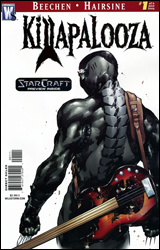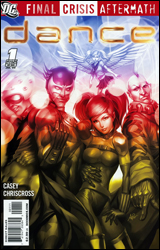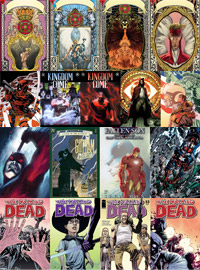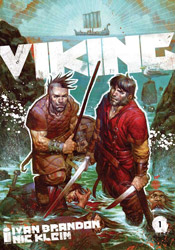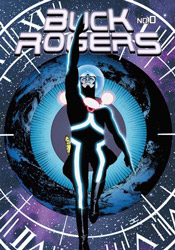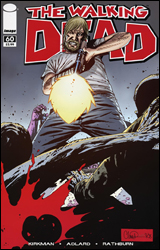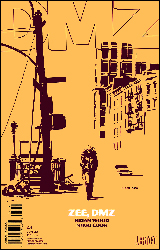A quick glimpse at what else I've been reading this month...
Deadpool: Suicide Kings #1 - I've never been a frothing Deadpool fanboy, but I had nothing else in mind when the guy at the counter suggested I pick up his last remaining issue and I'm glad I did. This won't make you go into deep thought or anything, but sometimes it's nice to shut off your brain and climb on board a roller coaster.
Suicide Kings reminds me of the early days of Spider-Man, when you could just jump in and have some fun without worrying about a big, heavy melodrama falling into your lap. Of course, there weren't quite as many guns, deaths or explosions in those old issues, but some things have to change with the times. The big star of this show was the artwork. Carlo Barberi is a great compliment to the character and the tone of the story - he never takes himself too seriously, and that's liberating. All around a fun little package.
7/10Marvel Knights: Angel #1 - I guess I missed this series when it was first being published. Stumbled across almost the entire run on the shelf this past week, when I didn't have anything new in my pull file and decided to give it a shot. The writing is terribly corny at parts, and it's tough to look past the glaring flaws in continuity but underneath all of that is a strangely appealing story about a kid who doesn't know why his body is turning on him. This is a five-issue mini, and I can already tell how it's going to play out just from the way everything's been set up, but I fully intend to see it through anyway. A big part of the reason is Adam Pollina's artwork. I've been aware of him for ages, appreciating him from a distance, but this is the first time I've seriously inspected one of his books. It's downright gorgeous and refreshingly original. I love the exaggerated bodies and bizarre accents he grants to each character, and he sets a scene like few others.
Angel wouldn't be worth a second glance without his aid
7/10Marvel Knights: Angel #3 - Issue #2 was nowhere to be found. Maybe I should have popped for the TPB collection instead. I kept waiting for something terrible to happen in this issue, but instead it caught me by surprise by focusing on Warren's jubilation in response to his wings finally sprouting. I've read the same old "mutant gets new powers, freaks out, gets run out of town by villagers with torches" angle so many times that it was really nice to see the other side of that coin, a kid who's utterly stoked about his mutation. Some of the developments hinted at the end of the issue weren't quite so unusual or even original, but hey, good with the bad.
7/10Marvel Knights: Angel #4 - Adam Pollina's artwork continues to blow me away within this series. In issue #3 he took my breath away with a full-page spread revealing the breadth of Warren's wings for the first time, and here he stunned me with another gorgeous cover and several more masterpieces inside. Roberto Aguirre-Sacasa quickly and neatly wrote his way out of the infuriating little corner he'd worked his way into at the end of last month and set the stage for the big finale. Probably the weakest issue of the series, as some of the kids' antics push the limits of believability, but overall it's still worth a look.
6/10Marvel Knights: Angel #5 - Keeps up a frantic pace from front to back, which is all you can really ask of a mini-series concluding issue. Pollina rebounds nicely from a shaky start to deliver on some of the best moments of the series, particularly when he allows a driving rainstorm to take shapes not entirely unlike Van Gogh's "Starry Night." I was hoping for a slightly longer touch on Angel's transition from student to X-Man, but I don't think the story really needed it and this issue already has enough going on as it is. I'm really glad I took a chance on this series, it was a good reminder of what the core
X-Men books used to be like, ages ago. Just a cluster of kids going through some unprecedented changes together, trying to help each other find the courage to carry on.
8/10Kingdom Come #3 - This was the spark. Waid and Ross spent three issues building up a house of cards, and I could almost feel their shared excitement as they filled their lungs with enough air to blow it all down. It's great to watch the individual arcs of all this book's supporting characters - Von Bach, Power Girl, the Satanist guy with nipple piercings... they each have a clearly defined progression and if you look in enough corners the whole world is laid out right there for you. This issue had so many enormous moments, it's tough to keep count. Clark and Diana discussing life, the universe and everything in the vacuum of outer space, Bruce's ultimate redemption, Captain Marvel's sudden, jarring arrival... this series deserves all the credit it gets. And as a consistent detractor of Alex Ross's work, that isn't especially easy for me to admit. This is his finest work, and it's more than likely the same story for Mark Waid.
10/10Kingdom Come #4 - One of the best fight scenes ever, and undoubtedly the most shocking conclusion to one. It's been so long since I read this issue, that final climactic moment at the end of the brawl literally left my jaw agape. Again. What's amazing about this issue is that it can do mindless violence while at the same time carry on a fascinating dialog on distant corners of the battlefield. It merges dozens of ongoing plot threads without feeling complicated or losing touch with the essence of its message. At the end of it all,
Kingdom Come doesn't tell you who was in the right and who was in the wrong. That judgment is left for the reader to decide. Terrific ending to an all-around epic mini-series. And I never use the word "epic."
10/10New Avengers #52 - I'll be honest: I've never been a fan of Dr. Strange. I know the guy has his share of support, but I've just never been any less than completely turned off by the whole "mystic arts" corner of the Marvel Universe. My eyes glaze over, I have to read speech bubbles three or four times over just to get the jist; it's almost a chore to get through. So, naturally I'm not all that taken by this arc, which focuses almost entirely on Strange's search for a successor. It's a different angle on the subject, with the Doc stepping down as Sorceror Supreme of his own volition, but I simply cannot get into it. On the visual side, Chris Bachalo's guest-spots aren't quite as good here as they were last month, but they still bring the right emotions to the right places. Sadly, Billy Tan also provides artwork, and he remains disgracefully bad. I think Ms. Marvel had six cheekbones in one panel. This is not my cup of tea.
3/10Ex Machina #41 - Well, that was quite the cold open. I've been lukewarm to this series for quite a while, but the opening press conference this month was just what I was waiting for. Finally we've got some direction, both inside and outside the mayor's office, and I'm anxious to see how everything plays out. I can't imagine Mayor Hundred is nearly as naive about January's real intentions as Vaughan is making it seem, although he does have some kind of penchant for writing innocent, gullible male leads so who really knows. Tony Harris has been solid on this series from the start, and shows no signs of relenting now. It's nice when your patience with a slow title finally pays off.
8/10Daredevil #118 - I'm not really sure what to say about that issue. Brubaker had me hooked on his run almost from the word go, but these last two arcs have really let me down. It's tough to root for a guy when he's interested in nothing more than constantly digging himself into a deeper hole, and that's all Matt's been doing for the last few years. Which isn't exactly new... in fact, it seems like that's been a golden ticket to surefire success on this title over the years. But where Miller, Bendis and even Kevin Smith succeeded by dragging Murdock through the wringers, Brubaker is stumbling. I think it's because he's robbed the character of his vigor. Matt just doesn't care any more, so watching him fall further and further into trouble is starting to seem like whipping the handicapped. We've got some serious potential in the machinations behind the scenes here, especially considering the bombshell Foggy drops midway through this month, but it's all being lost on an unrewarding main plotline. The mix-and-match artists of this arc aren't helping. Call this disappointing through and through.
4/10Batman: Gotham by Gaslight - Hadn't read this one in ages! Although the MSRP is now nearly than triple the $3.95 I originally paid for it, that's still a bargain. What I found most impressive about it this time around is how much story Augustyn and Mignola fit into such a short amount of space. This is an entire trade's worth of plot development smashed into a novel that's scarcely bigger than two single issues, but it doesn't feel hurried, rushed or any shorter than it needs to be. The concept of a Victorian Batman works even better than you'd expect, although he only appears in-costume for a few short scenes. Though I wasn't entirely taken by the whole Bats vs. Jack the Ripper dynamic, it's refreshing to see a one-shot Bruce Wayne period piece with only a fleeting mention of the Joker, so kudos for that. And Mignola, naturally, is Mignola. This came fairly early in his career, so his work isn't quite as refined as it later became, but I wouldn't trust these characters in this era to any other artist and he delivers. A very solid book, good for a short afternoon's entertainment, that doesn't overstay its welcome.
8/10Fallen Son: The Death of Captain America #5 - I was sure I'd missed the conclusion to this mini-series years ago, so when I saw it back on the shelves I snagged a copy on instinct alone. Turns out I did actually have a copy and had just forgotten everything about it. I kept waiting for something to happen, but for once we're treated to a major nonviolent event that actual remains that way. No surprise attacks from the Red Skull, no missiles pointed at the ceremony, just a grieving nation and a set of long-faced superheroes in their civvies. Cassaday's artwork floats from stirring to dull and back again several times. He sets an intense mood at the issue's onset - a slow pan back from Cap's casket, drawn by a single horse through the dreary streets of DC - but then slips up when Tony and the Falcon are delivering their eulogies. I really, really didn't like his rendition of the Thing, either. He gets a few chances to knock our socks off, via a set of flashbacks to crucial moments in Steve's life, with some more successful than others. Cap's final resting place was a nice touch, but otherwise this was just OK.
6/10Dark Avengers #4 - Well, shit, did this concept just click into place? I think it did! Between Doom surprising me by sensibly shooting down Osborn's suggestion they toy with the past, and Bullseye exchanging pleasantries with Venom on the battlefield, this issue was just plain fun. Maybe I missed out on something by skipping
Thunderbolts all this time, but the idea of a teamful of genuinely rotten supers just feels right to me at the moment. It certainly makes a nice change of pace from the usual stilted, buddy-buddy tone of mainstream hero books. Of course, they aren't doing anything particularly noteworthy, but the character interactions are enough to compensate for now. Deodato's artwork has its highs and lows - I really didn't care for his take on Moonstone as a walking, talking sex object wearing body paint. The rest of the team looks fine, though. I'm glad I took the plunge and started up on this series; I needed something to replace
Mighty Avengers in my pull list.
7/10The Walking Dead #51 - I stocked up on every issue the local shop had on its wall this week. This one was the crown jewel. Kirkman's story in #51 has everything: action, humor, horror and a heartbreaking reveal near its conclusion that had me thinking about it days later. I didn't even need to know the back story between Rick and his family to appreciate the moment, and Adlard's artwork matches the mood perfectly. Smart, succinct, successful storytelling (say that ten times fast) with effortless dialog and top-notch characterization makes this title worthy of all the praise. This is the way to jump into a new series - one of my favorite single issues of the year.
10/10The Walking Dead #52 - Not quite as accessible as the previous issue. A few familiar faces pop up this month, which left me feeling like a bit of an outcast. Kirkman doesn't make them intimidating or anything, but he also makes it clear that they share a long, rich history with the leads that I'm unaware of. Adlard's artwork may be better than last month, though... some of these compositions are jaw-dropping in their simplicity, while still managing to fill the page with an incredible level of detail. More than any of the other issues I've read, (of which there are now a few) this didn't stand on its own and felt like part one of a lengthy story arc. It's still great, but a few steps below perfection.
8/10The Walking Dead #53 - The reunion continues, with a few unexpected party crashers. If I was feeling left out by the joyous reconciliation last month, that feeling was multiplied by three here, as Rick and friends stroll into an entire village of old friends. The plot keeps moving along at a good clip, though, and each "new" face gets enough time to themselves that I was able to easily identify every personality before the end of the issue, which was missing from last month's story. I love that: Kirkman is so careful to make new readers feel welcome, while at the same time rarely holding anything back from his die-hards. There's something new and exciting for everybody.
9/10The Walking Dead #54 - Didn't take long for a few tempers to flare. What's nice is that the narration never chooses sides, doesn't designate a charming good guy or a dark, myserious bad guy. It's just two perspectives on a common problem that don't exactly line up. This cast is almost strong enough to write for themselves, so all Kirkman needs to do is introduce a moral quandry and toss in a herd of zombies to produce some serious drama. I'm not sure about the new additions to the cast just yet, but they're nothing if they aren't colorful and that's a good first step in my book. It's a little bit dialog-heavy in the first half, but I don't know how else the situation could have unfolded.
9/10
